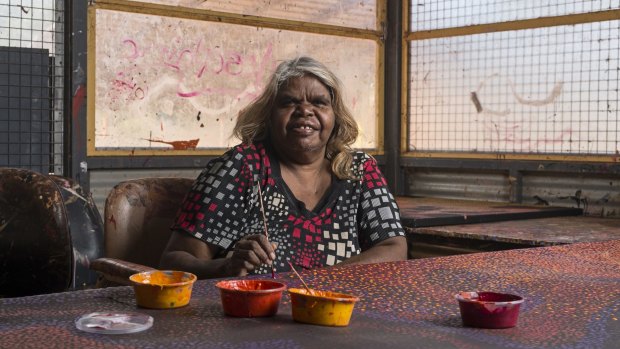This was published 5 years ago
How to buy authentic, ethical Western Desert art: tips from artist Nyunmiti Burtonis
By Belinda Jackson

Artist and teacher Nyunmiti Burton.
Nyunmiti Burton is an artist and teacher based in Tjala Arts in Amata, in South Australia's Anangu Pitjantjatjara Yankunytjatjara (APY) Lands. She is also a member of the NPY Women's Council, and works with Skye O'Meara, general manager of Sydney's APY Art Centre Collective. See tjalaarts.com.au
STEP ONE
If you're paying out hundreds of dollars for an artwork, can you be assured it's ethically produced? Is the artist being paid appropriately? Are they painting in a safe environment? Does the business you're buying from have full financial transparency? We know more about where our coffee and eggs come from than our Aboriginal art. So, do your research before you buy. Aboriginal-owned and operated art centres were set up to support local artists, and are publicly accountable, so you know that that canvas has been produced ethically. Desart is the peak body for more than 40 such art centres in Central Australia. See desart.com.au
STEP TWO
Visit an art centre. Some are open to visitors, such as long-running Ernabella (since 1948) in far northern South Australia, and Alice Springs' Iltja Ntjarra Many Hands Art Centre, run by the grandchildren of artist Albert Namatjira. Some are located on lands that require permits, and not all are open to the public, so contact the art centre before you visit, ernabellaarts.com.au, manyhands.com.au
STEP THREE
On the canvas itself, there should be written the artist's name, the name of the art centre and the artwork's catalogue number. When buying from private galleries and tourist sites such as Uluru, you can ask for work from specific art centres.
STEP FOUR
Don't haggle. When buying ethically produced art, you have to behave according to what's appropriate for an environment of significant disadvantage. The retail prices of the canvases are standard, and the artist receives the same percentage return, regardless of the price, which can be as little as 20 per cent in the private gallery structure, or as high as 60 per cent under the art centre model.
STEP FIVE
If you're buying from an art dealer, ask them: does this work come from an Aboriginal-owned art centre? Private galleries and art centres can't both be strong at the same time. When one is strong, the other is weak. For many, art centres are the only place where they can work while staying in the communities they live in – working either as an artist or in other support roles. Remember, when "carpetbaggers" (unethical dealers) are ripping off one artist in town, they're stealing from the children back in the community, who are most affected. Children must have that pathway to work in arts centres to make money and create a better future for their own children. That's what we elders are focused on.
The APY Collective gallery, in Darlinghurst, will open its second gallery on May 17 in Adelaide, see apygallery.com
Sign up for the Traveller newsletter
The latest travel news, tips and inspiration delivered to your inbox. Sign up now.